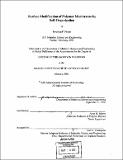| dc.description.abstract | Water filtration processes employing polymer membranes have become increasingly important over the past forty years. Due to their high efficiency and modularity relative to conventional processes, membrane separations are among a suite of emerging water treatment technologies which will make possible future water use sustainability, by enabling the decentralization of wastewater treatment and the recycling of currently unused wastewater streams. The application of these highly efficient processes is presently limited, however, by their high -operating costs relative to conventional processes, the most important cause of which is low fluxes and membrane failure due to fouling of the hydrophobic membrane materials by organics pervasive in feed waters. Current approaches to abate membrane fouling include substitution of more hydrophilic materials, as well as hydrophilic surface modification of hydrophobic membranes using coating and surface graft polymerization techniques. In many applications, the first approach results in unacceptable compromises in mechanical, thermal, and chemical stability. Coating and grafting techniques have been successful in reducing membrane fouling, but suffer from the disadvantages that (1) they require additional processing steps during membrane fabrication, increasing capital costs, (2) the coated or grafted layers obstruct membrane pores, reducing permeability, and (3) the hydrophilic surface layers have limited long-term stability. This thesis explores the preparation of membranes having tailored surface chemistries from polymer blends composed of poly(vinylidene fluoride) (PVDF, an important commercial hydrophobic membrane material) and a small proportion (5-10%) of an amphiphilic, comb shaped additive polymer designed for compatibility with PVDF. These blends self-organize during the aqueous coagulation and heat treatment steps of the standard immersion precipitation process for membrane fabrication, such that the amphiphilic polymer component is localized preferentially at the surface. The near-surface compositions of self-organizing membranes are quantified at the molecular level by X-ray photoelectron spectroscopy (XPS), and the surface chemistries so determined are related to membrane performance in a variety of adsorption, filtration, and wetting tests. The effect of the amphiphilic additive on membrane morphology is studied using electron microscopy. Much of the work presented herein centers on blends containing an inexpensive, free-radically synthesized comb additive designed for fouling resistance, P(MMA-r-POEM), which has a poly(methyl methacrylate) (PMMA) backbone and poly(ethylene oxide) (PEO) side chains. Using this additive, processing conditions and molecular architecture are optimized to take full advantage of surface segregation during the conventional steps of the commercial membrane fabrication process. Significant surface segregation is observed to occur during both the coagulation and aqueous heat treatment steps of the process. Using a coagulation bath heated to 90°C, a near-surface composition of -50 vol % comb (approaching 100% surface monolayer coverage) is obtained on a membrane with a bulk comb concentration of 15 vol % (10 wt %), requiring no post-coagulation processing. In an ultrafiltration experiment, membranes prepared using this single-step process exhibit fouling resistances comparable to membranes hydrophilized using coating and grafting methods. Significantly, addition of the comb results in an increase in the membrane porosity of up to an order of magnitude, compared to unmodified membranes having similar pore size distributions. Thus, due to the combined benefits of fouling resistance and increased porosity, a membrane containing 10 wt % of a comb having 45-unit PEO side chains has a flux over 20 times that of an unmodified PVDF membrane with equivalent separation characteristics after 3 h of filtration of a concentrated protein foulant solution. It is predicted and observed that the kinetics of membrane coagulation favor the surface segregation of higher molecular weight additives. Thus, the near-surface concentration of P(MMA-r-POEM) after coagulation increases monotonically with its molecular weight up to at least M, = 516 000 g/mol, based on polystyrene standards. This enables the preparation of membranes having robust, highly entangled surface layers composed of a water-insoluble comb. Surface layers prepared by self-organization are shown to be completely stable over at least 32 mo. of aqueous storage. Self-organization is shown to have significant advantages over the current surface modification methods. First, self-organization results in surface modification of all internal pore channels, in addition to the external surfaces modified by coating and line-of-site grafting techniques. This has important consequences with respect to fouling by through-pore foulants, as well as the use of immersion precipitation for the facile preparation of advanced devices having tailored surfaces, including filters for toxic metal recovery and scaffolds and barrier. materials for biomedical applications. Second, self-organizing membranes containing P(MMA-r-POEM) are potentially self-healing, in that surface layers damaged by acid exposure can be largely regenerated by subsequent heat treatment in water, which results in further surface segregation of residual comb from the bulk. Using a novel, industrially-relevant atom transfer radical polymerization technique, comb polymers having PVDF backbones and POEM or poly(methacrylic acid) (PMAA) side chains are prepared. PVDF membranes prepared in a single step from blends containing >5 wt % PVDF-g- POEM are spontaneously wettable by water. Similarly prepared membranes containing 10 wt % PVDF-g-PMAA are environmentally-responsive, in that the pores can be reversibly opened and closed by adjustment of the feed solution pH, which controls the conformation of the weak polyacid PMAA side chains expressed at the membrane surface. A reversible flux variation of over an order of magnitude is observed as the feed pH is changed from 2 to 8. Conformational changes of surface-expressed PMAA are confirmed by atomic force microscopy force-distance measurements. These results make "intelligent," environmentally responsive filtration membranes available with no extra processing steps, and demonstrate the versatility of self organization as a technique for imparting highly tailored surfaces to polymer membranes. | en_US |
